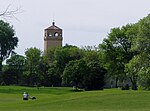William and Catherine Davern Farm House
1862 establishments in MinnesotaHouses completed in 1862Houses in Saint Paul, MinnesotaHouses on the National Register of Historic Places in MinnesotaItalianate architecture in Minnesota ... and 3 more
Minnesota Registered Historic Place stubsNational Register of Historic Places in Saint Paul, MinnesotaSaint Paul, Minnesota stubs

The William and Catherine Davern Farm House is an Italianate farmhouse built in 1862 in Saint Paul, Minnesota, United States. It is one of a small number of surviving farmhouses in Saint Paul. William Davern was a member of the first territorial legislature. The house is listed on the National Register of Historic Places.
Excerpt from the Wikipedia article William and Catherine Davern Farm House (License: CC BY-SA 3.0, Authors, Images).William and Catherine Davern Farm House
South Davern Street, Saint Paul Highland
Geographical coordinates (GPS) Address Nearby Places Show on map
Geographical coordinates (GPS)
| Latitude | Longitude |
|---|---|
| N 44.906194444444 ° | E -93.172777777778 ° |
Address
South Davern Street 1167
55116 Saint Paul, Highland
Minnesota, United States
Open on Google Maps





